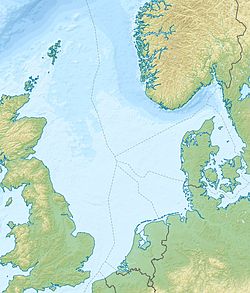Kotter and Logger oil and gas fields
The Kotter and Logger oil and gas fields are mid-size fields located in the Netherlands sector of the North Sea, about 40 km west of Den Helder and 107 km north west of Amsterdam. The Kotter and Logger oil fields produced oil from 1984/5 to 2015. The fieldsThe Kotter oil and gas fields are located in Block K18 of the Netherlands sector of the southern North Sea.[1] The oil reservoir is a Cretaceous/Jurassic sandstone at a depth of 7,500 feet (2,300 metres) and comprises two accumulations in Vieland and Delfland sands. The gas reservoir is an Upper Rotliegendes sandstone at a depth of 4,217 to 4,337 metres, below Zechstein salt.[2][3] The Logger oil field is in the adjacent Block L16[4] and is also a Cretaceous/Jurassic sandstone lying at a depth of 7,215 feet (2,199 metres), it has a thickness of 10 to 30 metres.[5] The Kotter oil field was discovered by Conoco in August 1980, the Logger oil field in March 1982, and the Kotter gas field in 1992, both also discovered by Conoco.[1][3] The properties of the reservoir/ wellhead fluids are:[1][5][2]
DevelopmentThe Kotter and Logger oil fields were developed though a number of platform installations.[1]
Oil from Logger was exported to Kotter. Oil from Kotter was exported to the Helder A platform and the combined flow sent to Amsterdam. Produced gas from both oil fields was flared. The K18-FB gas field adjacent to Kotter is a stranded asset with no gas transportation infrastructure and remains undeveloped.[6] The Logger installation had a water injection capability of up to 4 injection wells. Injection water was transferred from Kotter to Logger through a 19 km 6-inch pipeline.[1][7] The Kotter production facility was originally designed for these throughputs.[1][7]
The Logger installation had a production capacity of 10,000 bbl/d of oil.[1] The K18 Golf facility aimed to produce 1.0 to 1.4 million cubic metres of gas per day.[8] The Kotter and Logger fields were originally owned and operated by Conoco until they were taken over by Wintershall.[8] Production ceased in 2015 and the wells and installations were decommissioned and decontaminated. The platforms and jackets were removed from the field in 2019.[9] See also
References
|
|||||||||||||||||||||||||||||||||||||||||||||||||||||||||||||||||||||||||||||||||||||||||||||||||||||||||||||||||||||||||||||||||||||||||
Portal di Ensiklopedia Dunia














